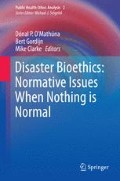Abstract
Communications about a pandemic can be extremely difficult, especially during the early stages when the seriousness of an outbreak is not clear and when—as happened during SARS—the threat was not at first understood. It is especially important that health care workers receive the same information as the public so that the same message goes out in individual conversations as in news releases. Even when issues are not clear, the best policy is to be as transparent as possible, admitting there is uncertainty. Inevitably, there will be ethical issues: should names of individuals who are ill or die be released? Should homes with ill persons be quarantined and placarded? If medical personnel refuse to work—as some surveys suggest may happen—should this be made public? Would it be ethical to break the law, for example a law on privacy, if this is deemed to be in the public interest? May the interests of the state over-ride individual rights and, if so, does the public have a right to know this? Transparency is always the best policy because individuals cope best when they know the truth.
Access this chapter
Tax calculation will be finalised at checkout
Purchases are for personal use only
References
Balicer, Ran D., Saad B. Omer, Daniel J. Barnett, and George S. Everly. 2006. Local public health workers perceptions’ toward responding to an influenza pandemic. BMC Public Health 6:99.
Barnett, Daniel J., Ran D. Balicer, Carol B. Thompson, J. Douglas Storey, Saad B. Omer, Natalie L. Semon, Steve Bayer, Lorraine V. Cheek, Kerry W. Gateley, Kathryn M. Lanza, Jane A. Norbin, Catherine C. Slemp, and Jonathan M. Links. 2009. Assessment of local public health workers’ willingness to respond to pandemic influenza through application of the extended parallel process model. PLoS ONE 4 (7): e6365.
Byerly, Carol R. 2005. Fever of war. New York: New York University Press.
Dehner, George. 2007. Flu: Past and present. History Compass 5:709–724.
Duffin, Jacalyn. 2006. Introduction: Lessons and disappointments. In SARS in context, eds. Jacalyn Duffin and Arthur Sweetman, 1-15. Kingston: McGill-Queen’s University Press.
Dynes, Russell, and Enrico Quarantelli. 1985. Role simplification in disaster. In Role stressors and support for emergency workers, Center for Mental Health Studies of Emergencies. Rockville, MD: National Institute of Mental Health.
Hodges, Nathaniel. 1666. Loimologia.
Iezzoni, Lynette. 1999. Influenza, 1918: The worst epidemic in American history. TV Books.
Joint Pandemic Working Group. n.d. Ethics and SARS: Learning lessons from the Toronto experience. Toronto: Joint Centre for Bioethics.
Kanihan, Stacey Frank, and Kendra L. Gale. 2003. Within 3 hours, 97 percent learn about 9/11 attacks. Media Studies of September 11 24:78–92.
Katz, Elihu, and Paul F. Lazarsfeld. 1955. Personal influence. Glencoe, IL: The Free Press.
Kraul, M. 2010. Immigration, ethnicity and the pandemic. Public Health Reports 125 (Suppl 3): 123–133.
Masterson, Lori, Christel Steffen, Michael Brin, Mary Frances Kordick, and Steve Christos. 2009. Willingness to respond of emergency department personnel and their predicted participation in mass casualty terrorist events. Journal of Emergency Medicine 36 (1): 43–49.
Mead, Richard. 1720. A short discourse concerning pestilential contagion and the methods used to prevent it. London: S. Buckley.
Pandemic Influenza Working Group. 2005. Stand on guard for thee. Toronto: Joint Centre for Bioethics.
Perry, Ron, and Michael Lindell. 1989. Communicating environmental risk in multiethnic communities. London: Sage.
Platt, Colin. 1997. King Death: The Black Death and its aftermath in late-medieval England. Toronto: University of Toronto Press.
Privacy, Act, Revised Statutes of Canada 1985, c. P-21, s. 8.
Reynolds, Amy, and Brooke Barnett. 2003. This just in… How national TV news handled the breaking ‘live’ coverage of September 11. Journalism & Mass Communication Quarterly 80:689–703.
Scanlon, Joseph, with Massey Padgham. 1980. The Peel Regional Police Force & The Mississauga Evacuation. Ottawa: Canadian Police College.
Scanlon, Joseph, Terry McMahon, and Casey Hurrell. 2009. Almost only women: Canadian volunteer response to the 1918–20 pandemic. American Journal of Disaster Medicine 4:331–344.
Seeger, Matthew W. 2006. Best practices in crisis communication: An expert panel process. Journal of Applied Communication Research 34:232–244.
Simmons, Kevin, and Dan Sutter. 2009. False alarms, tornado warnings and tornado casualties. Weather, Climate and Society 1:38–53.
Sims, Hugh Joffre. 1984. Simsʼ history of Elgin County. Shedden: Elgin County Library.
Stephens, Mitchell, and Nadyne Edison. 1982. An analysis of news media coverage of issues at Three Mile Island. Journalism Quarterly 59:199–204.
Tschanz, David W. 2011. Plague of the Spanish Lady. Military History Online. http://www.militaryhistoryonline.com/wwi/articles/plagueofspanishlady.aspx. Accessed 1 May 2013.
Twenty-Six, cases listed by board. 1920. The Morning Chronicle, February 14, p. 4.
White, Meda Miller. 1962. Role conflict in disasters: Not family but familiarity first. Chicago: University of Chicago.
World Health Organization. 2005. WHO outbreak communication guidelines. Geneva: World Health Organization.
Xuewen, Sheng. n.d. Emergency response in the People’s Republic of China: A case study of the 1987 Daxinganling forest fire. Unpublished paper.
Author information
Authors and Affiliations
Corresponding author
Editor information
Editors and Affiliations
Rights and permissions
Copyright information
© 2014 Springer Science+Business Media Dordrecht
About this chapter
Cite this chapter
Scanlon, J. (2014). Ethical Issues in Health Communications: Strategies for the (Inevitable) Next Pandemic. In: O’Mathúna, D., Gordijn, B., Clarke, M. (eds) Disaster Bioethics: Normative Issues When Nothing is Normal. Public Health Ethics Analysis, vol 2. Springer, Dordrecht. https://doi.org/10.1007/978-94-007-3864-5_6
Download citation
DOI: https://doi.org/10.1007/978-94-007-3864-5_6
Published:
Publisher Name: Springer, Dordrecht
Print ISBN: 978-94-007-3863-8
Online ISBN: 978-94-007-3864-5
eBook Packages: Humanities, Social Sciences and LawPhilosophy and Religion (R0)

